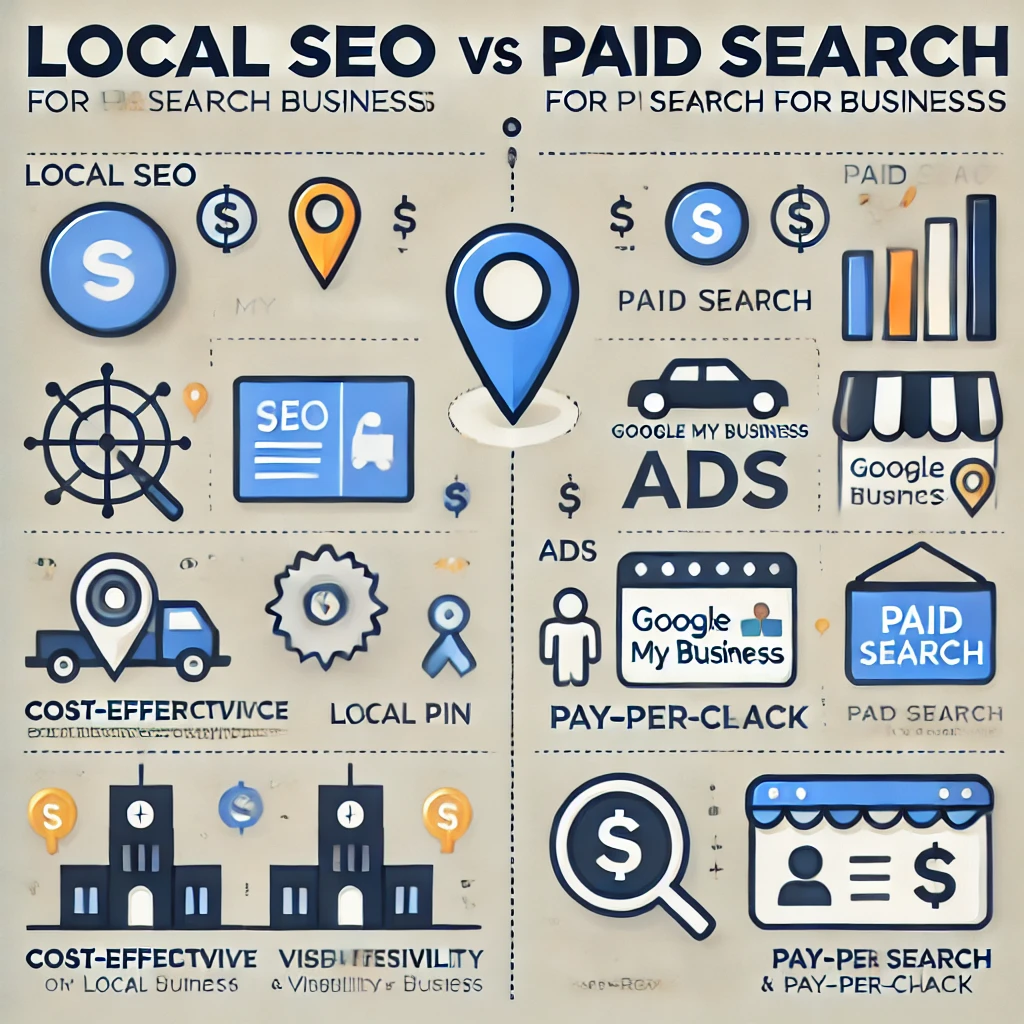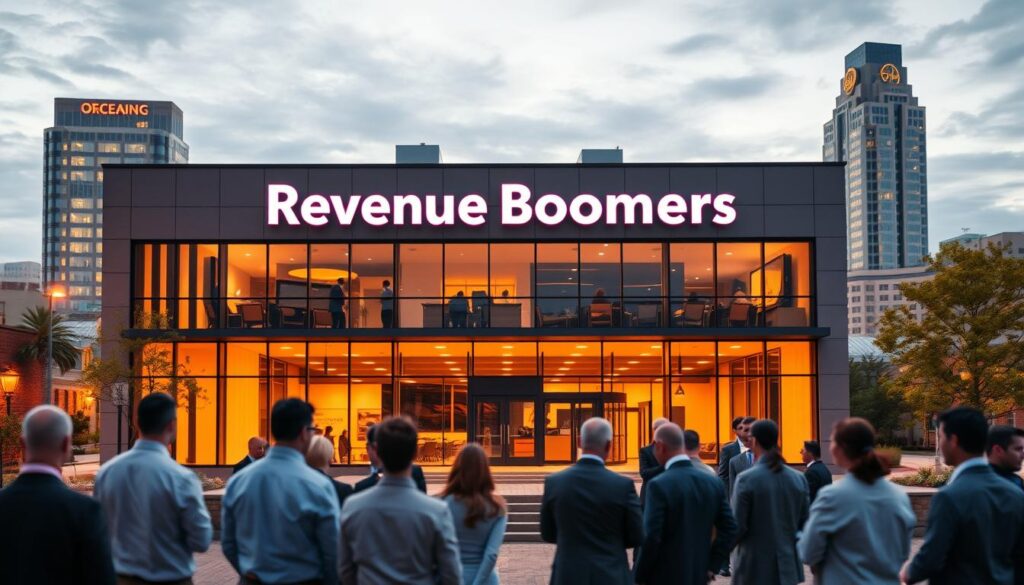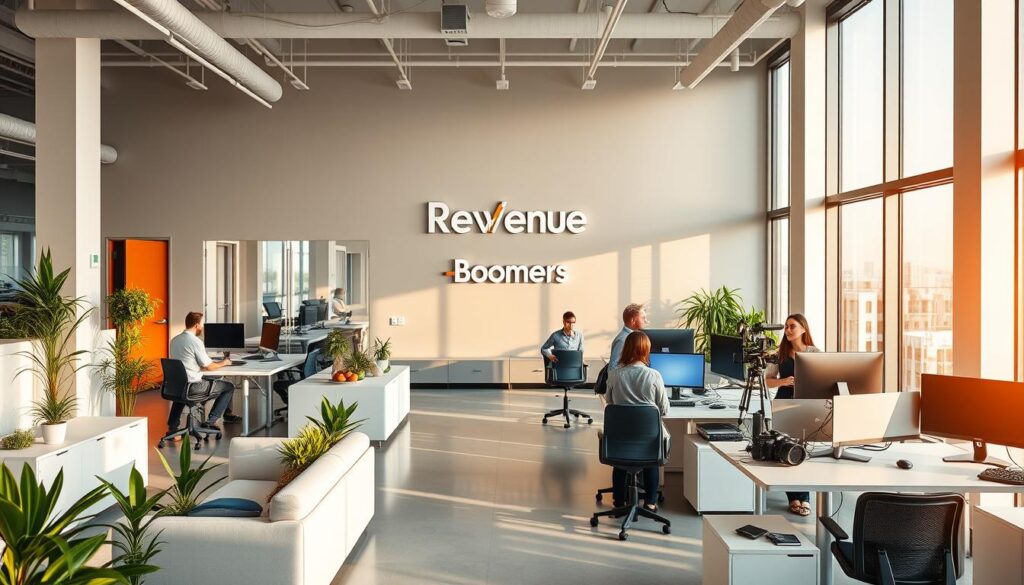Introduction
For businesses aiming to increase visibility, especially within specific geographic areas, deciding between local SEO and paid search can be challenging. Both strategies can attract more customers, but each has unique benefits and fits different goals, budgets, and timelines. Local SEO focuses on organic visibility, helping businesses appear in local searches without paying per click, while paid search provides immediate visibility through ads. This blog dives deep into the pros, cons, and comparisons of local SEO and paid search to help you decide which is best for your business. Book a free local SEO consultation with Revenue Boomers to discuss how each approach could work for your business goals.
Table Of Contents
- Overview Of Local SEO
- Overview Of Paid Search
- Local SEO vs. Paid Search: Key Differences
- Benefits Of Local SEO
- Benefits Of Paid Search
- When To Use Local SEO or Paid Search
- Combining Local SEO and Paid Search
Overview Of Local SEO
Local SEO is designed to boost a business’s organic search rankings for location-based searches. This strategy includes optimizing the website with location-specific keywords, managing Google My Business (GMB), acquiring local reviews, and listing in local directories. The goal of local SEO is to ensure that the business appears in the “local pack” and map results when users search for services nearby, such as “dentist near me” or “flower shop in [city].”
Core Elements of Local SEO:
- Google My Business (GMB): Ensuring accurate information, responding to reviews, and optimizing your profile for local searches.
- Local Citations: Getting listed in online directories and maintaining consistency across listings.
- On-Site Optimization: Including location-based keywords, updating title tags, and optimizing for mobile.
- Content Marketing: Publishing locally relevant content to build authority within the community.
Learn more about the basics of local SEO here
Overview Of Paid Search
Paid search (often PPC or pay-per-click) involves bidding on specific keywords to make ads appear at the top of search results. Unlike organic SEO, which can take time to show results, paid search delivers immediate visibility, making it a faster way to attract new customers. Google Ads is the most popular platform, allowing businesses to customize ad targeting based on location, demographics, interests, and search intent.
Core Elements of Paid Search:
- Keyword Bidding: Choosing specific keywords to bid on based on search volume and competition.
- Ad Copy and Landing Pages: Creating compelling ad copy and optimized landing pages that encourage clicks and conversions.
- Targeting Options: Segmenting the audience based on location, interests, or demographics.
- Budgeting and Bidding: Setting daily budgets and managing bids to control ad spend.
Local SEO vs. Paid Search: Key Differences
| Feature | Local SEO | Paid Search |
|---|---|---|
| Cost | Generally a one-time or low-maintenance cost; no charge per click | Pay-per-click; costs accumulate with more clicks |
| Time to See Results | Slower (3-6 months or more) | Immediate (ads show as soon as campaigns launch) |
| Sustainability | Long-term; organic results continue without ongoing spending | Short-term; visibility stops once budget is depleted |
| Trustworthiness | High (organic results are seen as credible and unbiased) | Moderate (some users may skip ads, preferring organic results) |
| Click-Through Rates | Typically higher for organic listings (local SEO) | Lower for ads but allows detailed tracking of click behavior |
| Best For | Building long-term, consistent presence in local search | Gaining quick visibility or testing keywords quickly |
Benefits Of Local SEO
Local SEO provides sustainable, organic growth that builds over time. Here’s why it may be a great option:
- Credibility and Trust: Organic listings are typically viewed as more trustworthy than ads, which may lead to higher engagement rates over time.
- Cost-Effective: Local SEO involves initial optimization costs but incurs no ongoing fees per click, making it ideal for businesses on a budget.
- Long-Term Results: Once local SEO is established, the business can maintain rankings with minimal ongoing costs, unlike paid search.
- Local Targeting: Optimizes for local searches, helping businesses attract customers in the area, which is critical for service-based businesses like restaurants, clinics, and repair shops.
Local SEO is best for businesses with a long-term growth plan, looking to sustain their online visibility without frequent spending.
Benefits Of Paid Search
Paid search is a great option for businesses that want fast results and don’t mind investing in ongoing advertising costs:
- Instant Visibility: Ads can appear at the top of search results within hours of launching a campaign, ideal for time-sensitive promotions.
- Targeted Reach: With paid search, businesses can precisely target audiences by location, demographics, and even device, making it highly customizable.
- Scalability: Paid campaigns can easily scale up or down based on budget, making it flexible for businesses that want more control over their advertising.
- Detailed Analytics: Paid platforms like Google Ads provide detailed insights on clicks, conversions, and costs, allowing businesses to track the exact ROI of their campaigns.
Paid search is ideal for quick, targeted campaigns where immediate results are essential, such as new product launches or seasonal promotions.
When To Use Local SEO Or Paid Search
- Local SEO: If your goal is to establish a long-term presence in organic search results, focus on local SEO. It’s effective for businesses that want steady, sustainable traffic without constant spending. Examples: Dental practices, gyms, home service providers.
- Paid Search: If you need rapid visibility or are running a time-sensitive campaign, paid search can give you an immediate presence. This approach is also helpful for testing keywords or gaining a quick understanding of search interest. Examples: Event promotions, new business openings, or special sales.
Combining Local SEO And Paid Search
Many businesses find that a hybrid approach works best, using both local SEO and paid search in tandem. Here’s how they can complement each other:
- Build Immediate Traffic with Paid Ads: While working on local SEO, paid search ads can generate immediate clicks and bring traffic to your site.
- Use Paid Search to Test Keywords: Paid ads can help identify high-converting keywords, which can then be integrated into local SEO efforts.
- Establish Long-Term Presence with Local SEO: As organic rankings improve, the reliance on paid ads can be reduced, ultimately saving costs.
- Gain Greater Control Over Visibility: Combining both approaches gives you control over immediate visibility (paid) and long-term reach (SEO), allowing a more flexible marketing strategy.
Frequently Asked Questions (FAQs)
How Long Does Local SEO Take To Show Results?
Local SEO typically takes 3 to 6 months to show results, while paid search provides immediate visibility once the campaign starts.
Is Paid Search More Expensive Than Local SEO?
Paid search can become more costly over time since it requires a budget for each click, whereas local SEO involves one-time optimization costs.
Which Strategy Is Better For Small Businesses?
Small businesses often benefit from local SEO for cost-effective, long-term results. However, combining both can provide immediate and sustainable visibility.
Can Local SEO And Paid Search Be Used Together?
Yes, using both strategies can provide immediate visibility from ads and sustained traffic from local SEO.
What Is The Cost Range For Paid Search?
Paid search costs vary widely, typically depending on keyword competition, but often range from $500 to several thousand dollars monthly.
Best SEO And Paid Search Strategy Near Me
Understanding whether local SEO or paid search best suits your needs is crucial for maximizing visibility. While local SEO builds long-term traffic, Google ads provides instant results. Reach out to Revenue Boomers to discuss a personalized approach that aligns with your business goals and budget.






